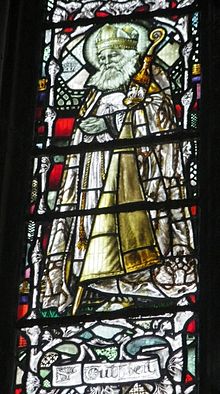St Cuthbert of Lindisfarne
Cuthbert (634-87) was an English Benedictine monk born in Northumbria during a time of strife between that Christian kingdom and pagan neighbour Mercia. He seems to have been a soldier in those wars before joining a monastery that practiced the Celtic ritual. When his monastery adopted the Roman approach, he moved to another establishment but finally accepted the decision of the 664 Synod of Whitby that standardized northern English worship on the Latin model.
By this time he already had a reputation for saintliness and miracle working so he was chosen by Theodore of Tarsus, the Archbishop of Canterbury, to become prior of the great Lindisfarne monastery and guide their shift to the Roman usage. He retired for a time to a life of contemplation but reluctantly abandoned that when asked to be bishop. After his death his tomb became the site of numerous miracles.
The story of St Cuthbert’s body deserves a book of its own. When the Vikings invaded in 875, the body of the saint was removed for safety and went on a seven-year journey through Cumberland, Galloway and Northumberland. In 883 it was placed in a church at Chester-le-Street, but was moved a century later to Ripon when another invasion loomed. On its way through Durham a miracle indicated that this was where the saint wished to finally rest. When William the Conqueror was laying waste to the north of England in 1069, Cuthbert was taken to Lindisfarne and then back again to Durham. In 1104, his shrine was transferred to Durham cathedral where it was discovered that the body remain uncorrupt (a sure sign of sainthood) and that it held the head of the martyr St Oswald. As the stained glass above indicates, this has become Cuthbert’s symbol. During the Middle Ages, his shrine was the destination of thousands of pilgrims. During the English Reformation when so many holy sites were destroyed in fits of iconoclasm, Cuthbert’s body was moved in 1542 to a secret location which, legend says, only a few Benedictines in each generation know of.
